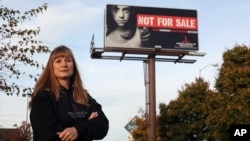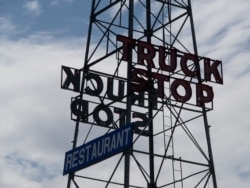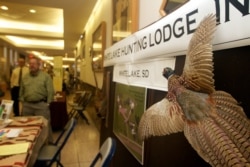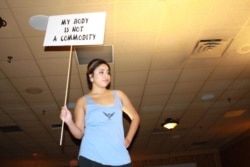Note: This report contains language or content that some may find disturbing or offensive.
“I was very young when I was introduced to a pedophile,” said Lisa, 41, a survivor of sex trafficking who asked that her real name not be used. Raised on an Indian reservation in South Dakota, she cites a family history of sexual abuse.
“My mother was sent to a boarding school where the dean raped her repeatedly,” she said.
She believes she is the product of that rape.
“Later on, my mother got involved with men who were part of a pedophile ring. I’d wake up in the middle of the night, and I’d see prominent people from the community at our house — even the local sheriff.”
Sometimes, she said, her stepfather would “rent them out” to the landlord to cover the monthly rent.
Julie, a 31-year-old trafficking survivor grew up in foster care on a different South Dakota reservation. When she was 13, her foster father, a long-distance trucker, began taking her along on road trips.
“We’d pull into truck stops, and if I wanted to eat, I would have to go to other truck drivers and do sexual things,” she said.
At 14, she got pregnant.
“We lived on a farm. They’d say whatever I gave birth to, they’d feed it to the pigs,” she said, crying. She believes they made good on that promise.
At 16, she ran away.
"They found out where I was, and they came and took me back home. And then they would lock me up in the basement for weeks at a time," she said.
Julie and Lisa’s stories are sadly familiar, says Melissa Farley, a clinical psychologist and founder of Prostitution Research and Education (PRE), a San Francisco-based nonprofit. She says most trafficking victims in America come from vulnerable, oppressed or marginalized groups because they are the easiest to recruit and control. Children are especially vulnerable because they are easier to manipulate.
Historical prey
Native American women have always been vulnerable to sexual predators. Historians say early explorers, trappers and settlers read Native women’s dress and comparative freedoms as signs of moral defect and “assumed the right to kidnap, rape and prostitute Native women and girls without consequence.”
During the 19th and 20th centuries, the U.S. government forced Native children into residential boarding schools where violence and sexual abuse were rampant. That history of trauma, combined with the poverty, addiction and other social ills on rural reservations, left Native women especially vulnerable to being trafficked, even by their own families.
“You have three or four kids, and you and your children are hungry. And someone comes along and says, ‘Give the child to me. I'll put her through school. I’ll make sure she gets a really good job. And oh, here's a thousand dollars,’” Farley told VOA.
A market state
The problem is especially bad in South Dakota, where Native Americans make up only 8% of the population but 40% of trafficking victims.
Pheasant and big game hunting attract tens of thousands of hunters to the state each autumn. Hundreds of thousands of motorcycle enthusiasts attend the annual summer Sturgis Motorcycle Rally.
Each year, state and federal law enforcement agents have conducted undercover sex trafficking "stings” during the Rally, targeting individuals seeking to purchase sex with minors. According to the U.S. Justice Department, these operations have resulted in 62 arrests.
Kelly R. Patterson founded and directs Treasured Lives, a nonprofit organization that offers support, crisis care and mentoring to trafficking survivors in South Dakota.
“Whenever you have a gathering of men anywhere, you always have bad apples. And the traffickers know that,” Patterson said.
A survivor herself, she relates her own experience at Sturgis.
“The trafficking ring loaned me out for two months to a very well-known motorcycle club because I was always trying to escape,” she said. “What they didn't know was I would have preferred to stay with the bikers, because at least with them, I wasn't being tortured.”
Recruitment
Traffickers have increasingly turned to social media to recruit young victims, luring them with false promises of jobs, money or drugs, or threatening them with violence. Most victims enter trafficking between ages 12 and 14 and include young boys.
A 2011 study of Native American prostitutes in Minnesota revealed that the majority had been abused as children by an average of four men and were tricked into the sex trade with no understanding of what they were getting into.
According to the nonprofit Nonstate Torture, sex traffickers use a variety of physical, sexual and psychological methods to “break” victims: They may deprive them of food or sleep, humiliate them or torture them into submission.
“I’ve heard from women who are put in dog cages and treated like a dog, forced to wear a dog collar, no clothing, and even to eat dog food," said Patterson. “And when they were let out, they were forced to sit on their hands and knees like dogs.”
Patterson knows of child victims who were made to believe a doll was a live baby, then forced to stab it with a knife.
“And then the trafficker told them, ‘See how bad you are? You killed a baby,’” Patterson said.
Rituals
Sometimes, torture involves elements of ritualism.
Lisa’s abusers claimed to be “Satanists,” something she says is “big” on reservations.
“Whether they believe it themselves for real or not, I don’t know. But they make you believe it’s real,” she said. “They’ll wear devil masks just to scare kids.”
A 2014 study by Los Angeles public health officials shows that fear and violence ultimately create an emotional bond with the trafficker that may be difficult to break.
Barriers to identifying and freeing victims
Some local advocates say trafficking is a low-risk crime in South Dakota, a state with plenty of open space and room to hide.
Studies show that local law enforcement agencies often lack the training, tools and protocols to recognize human trafficking, even when it is going on in plain sight.
Tribal police are severely underfunded and understaffed. Huge caseloads mean they may prioritize other crimes.
Sometimes, the police may fail to act, citing a lack of evidence or the belief that victims are willing participants in the sex trade.
Traffickers constantly move victims across jurisdictions, and tribal, local and state police may fail to share information.
And, as Julie suggested, some police officers themselves may be involved in trafficking, though VOA was unable to corroborate her statement.
Media, lawmakers can do more
Lisa Hope Heth is the founder of Wiconi Wawokiya, Inc. (Helping Life), a nonprofit working to end domestic and sexual violence on the Crow Creek Reservation in South Dakota.
She believes that the media is not doing enough to raise public awareness.
“Maybe it’s because bringing attention to trafficking might deter tourists and hunters from bringing money into the state,” she said.
Heth is currently working to help the Lower Brule and Crow Creek Nations take matters into their own hands.
“We've decided to share these cases amongst ourselves so the local law enforcement can look into them,” she said. “If they find anything, then they can pull the feds [FBI] in.”
All 50 U.S. states prohibit human trafficking. South Dakota has also created a victims’ assistance program, which funds programs that shelter, counsel and advocate for victims of sexual assault, domestic violence, trafficking and other violent crimes.
It was one of the first states to aggressively prosecute buyers of sex from trafficked victims. But the advocacy group Shared Hope says South Dakota needs to work harder to ensure child victims are not criminalized.
South Dakota Governor Kristie Noem signed a bill in March making the torture of sex trafficking victims a Class I felony in that state. Representative Peri Pourier, a Democrat from the Pine Ridge Reservation, introduced legislation which, if signed, would require the state’s attorney general to create and staff an office dedicated to handling missing person cases.














